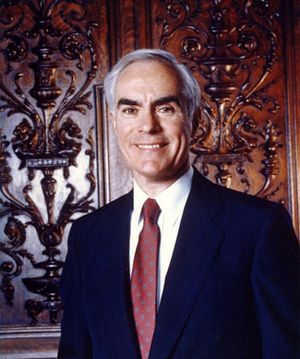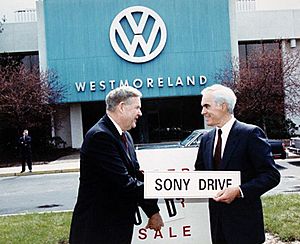Bob Casey Sr. facts for kids
Quick facts for kids
Bob Casey Sr.
|
|
|---|---|
 |
|
| 42nd Governor of Pennsylvania | |
| In office January 20, 1987 – January 17, 1995 |
|
| Lieutenant | Mark Singel |
| Preceded by | Dick Thornburgh |
| Succeeded by | Tom Ridge |
| 45th Auditor General of Pennsylvania | |
| In office January 18, 1969 – January 21, 1977 |
|
| Governor | Raymond P. Shafer Milton Shapp |
| Preceded by | Grace M. Sloan |
| Succeeded by | Al Benedict |
| Member of the Pennsylvania Senate from the 22nd district |
|
| In office January 1, 1963 – November 30, 1968 |
|
| Preceded by | Hugh J. McMenamin |
| Succeeded by | Arthur Piasecki |
| Personal details | |
| Born |
Robert Patrick Casey
January 9, 1932 Jackson Heights, Queens, New York, U.S. |
| Died | May 30, 2000 (aged 68) Scranton, Pennsylvania, U.S. |
| Resting place | Saint Catherine's Cemetery, Moscow, Pennsylvania, U.S. |
| Political party | Democratic |
| Spouse | Ellen Harding |
| Children | 8, including Bob Jr. |
| Alma mater | College of the Holy Cross (BA) George Washington University (JD) |
Robert Patrick Casey Sr. (January 9, 1932 – May 30, 2000) was an American lawyer and politician. He served as the 42nd governor of Pennsylvania from 1987 to 1995. Before that, he was a member of the Pennsylvania Senate and the Pennsylvania Auditor General.
Casey strongly supported workers' rights and believed that government could help people. He also supported gun rights. His son, Bob Casey Jr., later became Auditor General and is now a U.S. Senator for Pennsylvania.
Contents
Early Life and Education
Robert Patrick Casey was born in Jackson Heights, Queens, New York. His family was from Scranton, Pennsylvania. His father, a former coal miner, moved the family to New York so he could study law. After Robert was born, they moved back to Scranton.
Casey went to Scranton Preparatory School. He was a talented athlete and even turned down an offer to play baseball for the Philadelphia Phillies in 1949. Instead, he chose to go to college. He attended the College of the Holy Cross on a basketball scholarship, where he played with future NBA star Bob Cousy. He graduated in 1953.
He then earned his law degree from George Washington University in 1956. After law school, Casey worked for a law firm in Washington, D.C. He returned to Scranton in 1958 to start his own law practice.
Political Career
Serving in the State Senate
Casey became a member of the Democratic Party in the Pennsylvania State Senate. He represented the 22nd district from 1962 to 1969.
He tried to become Governor of Pennsylvania three times before he finally won. He ran in 1966, 1970, and 1978, but lost the primary election each time. Even though he was sometimes frustrated with his party, he never accepted offers from the Republican Party to run for governor with them.
Becoming Auditor General
In 1968, Casey was elected as the Auditor General of Pennsylvania. He was re-elected in 1972. The Auditor General's job is to check how the state's money is being spent. Many people thought he was one of the best Auditor Generals Pennsylvania ever had.
During his time in this role, Casey was known for finding problems and exposing corruption. He hired many public accountants to help him. He investigated many state contracts, like those for day care, Medicare, and highways. When he found mistakes or small acts of corruption, it often made headlines.
A Confusing Name
After his time as Auditor General, Casey decided not to run for another state office. However, a few other people named Robert Casey ran for different political jobs. This caused a lot of confusion for voters! People sometimes voted for the wrong "Robert Casey" by mistake. This led to campaigns trying to explain that "Casey isn't Casey" to help voters know who they were voting for.
Winning the Governor's Race
After practicing law for ten years, Casey decided to run for governor a fourth time in 1986. To avoid confusion, he called himself the "real Bob Casey." Some people joked about him being "the three-time loss from Holy Cross" because he had lost three times before.
This time, he hired two smart political advisors, James Carville and Paul Begala. Casey won the Democratic primary election. Then, he faced William Scranton III in the general election. The race was very close. Casey won by about 79,000 votes.
Governor of Pennsylvania

Robert Casey became Governor on January 20, 1987. He believed in an "activist government," meaning he thought the government should actively work to improve people's lives.
He made many changes, including:
- Expanding health care for women.
- Reforming the state's welfare system.
- Creating an insurance program for children who didn't have health insurance. This program, called CHIP (Children's Health Insurance Program), later became a model for a successful national program in the U.S.
Casey also started a "capital for a day" program. This meant the state's official business would be done from different communities across Pennsylvania, not just the capital city. Even though some people criticized his spending, Casey remained popular. He easily won re-election in 1990.
Organ Donation and Health Issues
In 1991, during his second term, Governor Casey was diagnosed with a rare inherited disease called amyloidosis. This disease causes harmful proteins to build up in organs. To treat it, he had a very rare heart-liver transplant on June 14, 1993.
Before his surgery, he temporarily gave his power as governor to Lieutenant Governor Mark Singel. This was the first time Pennsylvania had an acting governor. Casey returned to his duties about six months later.
After his operation, Casey strongly supported laws that encouraged organ donation. He helped create a fund to promote the benefits of organ donation, which was named in his honor.
Later Life and Passing
Casey could not run for a third term as governor, so he left office on January 17, 1995. He thought about running for President in 1996 but decided not to because of his health.
In 1996, he wrote a book about his life called "Fighting for Life."
Even after his transplants, Casey continued to have health problems from his disease. He passed away from a viral infection on May 30, 2000, at the age of 68. He was buried in Saint Catherine's Cemetery in Moscow, Pennsylvania.
He and his wife, Ellen, were married for fifty years and had eight children. One of their children is Bob Casey Jr., who followed in his father's footsteps in politics.
See also
 In Spanish: Robert P. Casey para niños
In Spanish: Robert P. Casey para niños

